Category: Design Fiction
KTH 2018 PhD Supervisory Panel
Today was our department’s annual PhD Supervisory Panel at KTH during which PhD students are given the opportunity to get feedback from senior researchers who act as “guest supervisors.” To prepare for my meeting with two Associate Professors I reworked my research abstract and research questions following my 30% seminar in October, during which Johan Redström from Umeå Institute of Design acted as my discussant. My goals in today’s supervisory panel were to get feedback on the new scope of my abstract and research questions relative to being only about 40% through my PhD (and I’m sure will continue to evolve), and identify important areas that I need to work on articulating to more firmly position my research in the context of how I am conceptually “furnishing” my design space. Considering I was presenting to senior researchers from different academic backgrounds than my own and each other, it was especially helpful to see within which aspect I felt misunderstood, i.e. where I need to sharpen my arguments. Below my poster summarizing my research thus far, followed by a few notes/reflections based on feedback received today, and a textual version of my abstract and research questions.
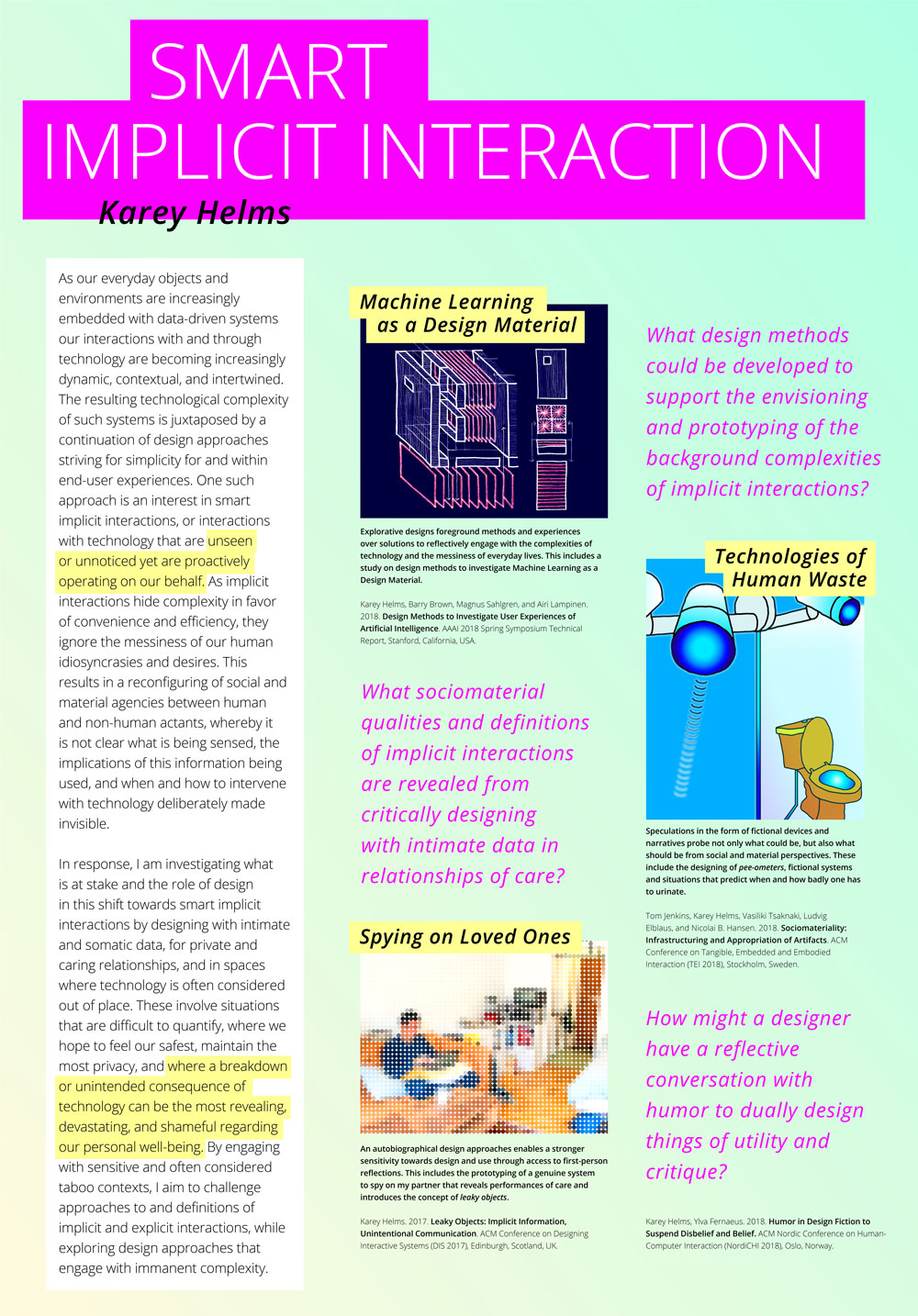
UID Wednesday Lecture 2018 – Crafting Humorous Fictions & Taboo Frictions
Yesterday I had the pleasure of spending the day at Umeå Institute of Design (where I did my MFA in Interaction Design). In the morning I spent a couple hours with upcoming IxD master thesis students to discuss my experience, and in the afternoon gave a talk titled “Crafting Humorous Fictions & Taboo Frictions” as part of the design school’s Wednesday lecture serious. Was great to be back, even if only for a day! Below is the abstract of my talk.
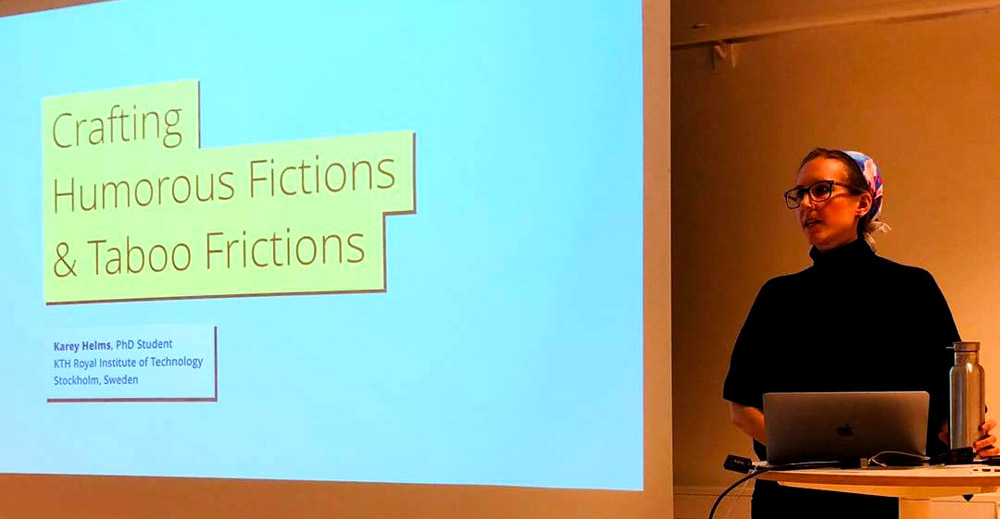
Talk abstract
Karey Helms is a PhD Student at KTH Royal Institute of Technology researching smart implicit interactions, those that are unseen or unnoticed yet proactively operate on our behalf. Her research through design approach includes speculative and autobiographical methods in which she designs humorous fictions and taboo frictions with intimate and somatic data to surface the social and societal implications of data-driven systems. These include the designing of fictional devices that predict when and how badly one has to urinate, and the prototyping of a genuine system to spy on her partner.
In this talk, she traces back her playful approach to fiction and friction to her master’s thesis in Interaction Design at UID and how she employed this approach while working in industry delivering actualized services within enterprise IoT prior to beginning her PhD. The aim of this talk is to advocate for humor in design and to craft experiences that disrupt and disturb to not only provoke others to think, but also yourself as a designer.
NordiCHI 2018 – Presentation & Slides
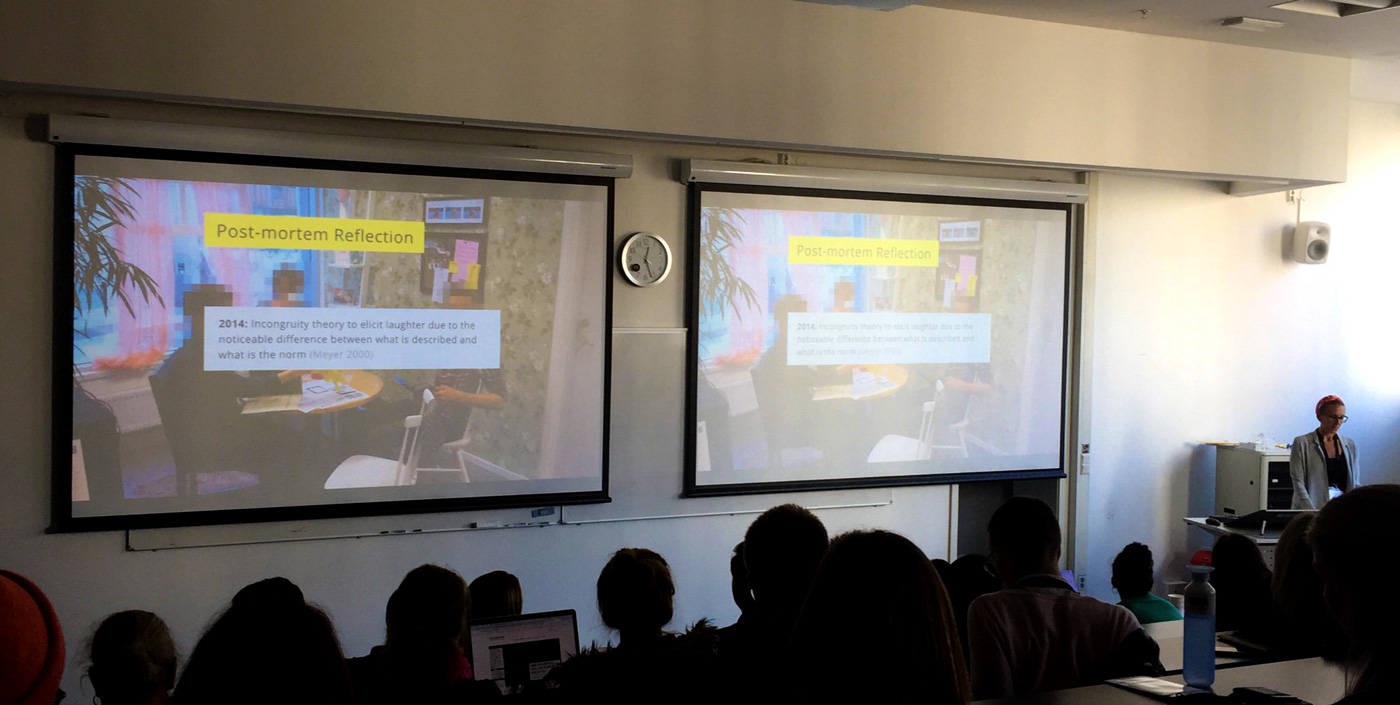
Early this week I presented a paper written with my PhD supervisor Ylva Fernaeus on the use of Humor in Design Fiction to Suspend Disbelief and Belief at NordiCHI 2018 in Oslo. This paper was part of the future scenarios track at NordiCHI, an excellent initiative and venue that explores the design of design fictions. Our paper contributed (1) a way in which humor might be used in design fiction (and design more broadly), (2) a design process that includes fieldwork to inform the design of design fictions, (3) and a human-scale design fiction as a method of communication and dissemination. For the presentation, I originally intended to role-play the paper presentation as a character from the fictional world, as I did when presenting the same project four years ago in Umeå as my master’s thesis, but last minute opted to not because of the opening introductions by moderators. Instead, I opened the presentation by jumping into the fiction with no context, and then gradually introduced more information and built reflections throughout the remaining of the presentation. I think this structure worked very well. The full paper is available here and the presentation below.
NordiCHI 2018 – Accepted Paper (Future Scenarios)
Very excited to have a NordiCHI 2018 paper accepted in the future scenarios track! Written with Ylva Fernaues, my supervisor at KTH, the paper is about why and how I used humor in my MFA thesis at Umeå Institute of Design four years ago.
Karey Helms, Ylva Fernaeus. 2018. Humor in Design Fiction to Suspend Disbelief and Belief. ACM Nordic Conference on Human-Computer Interaction (NordiCHI 2018), Oslo, Norway.
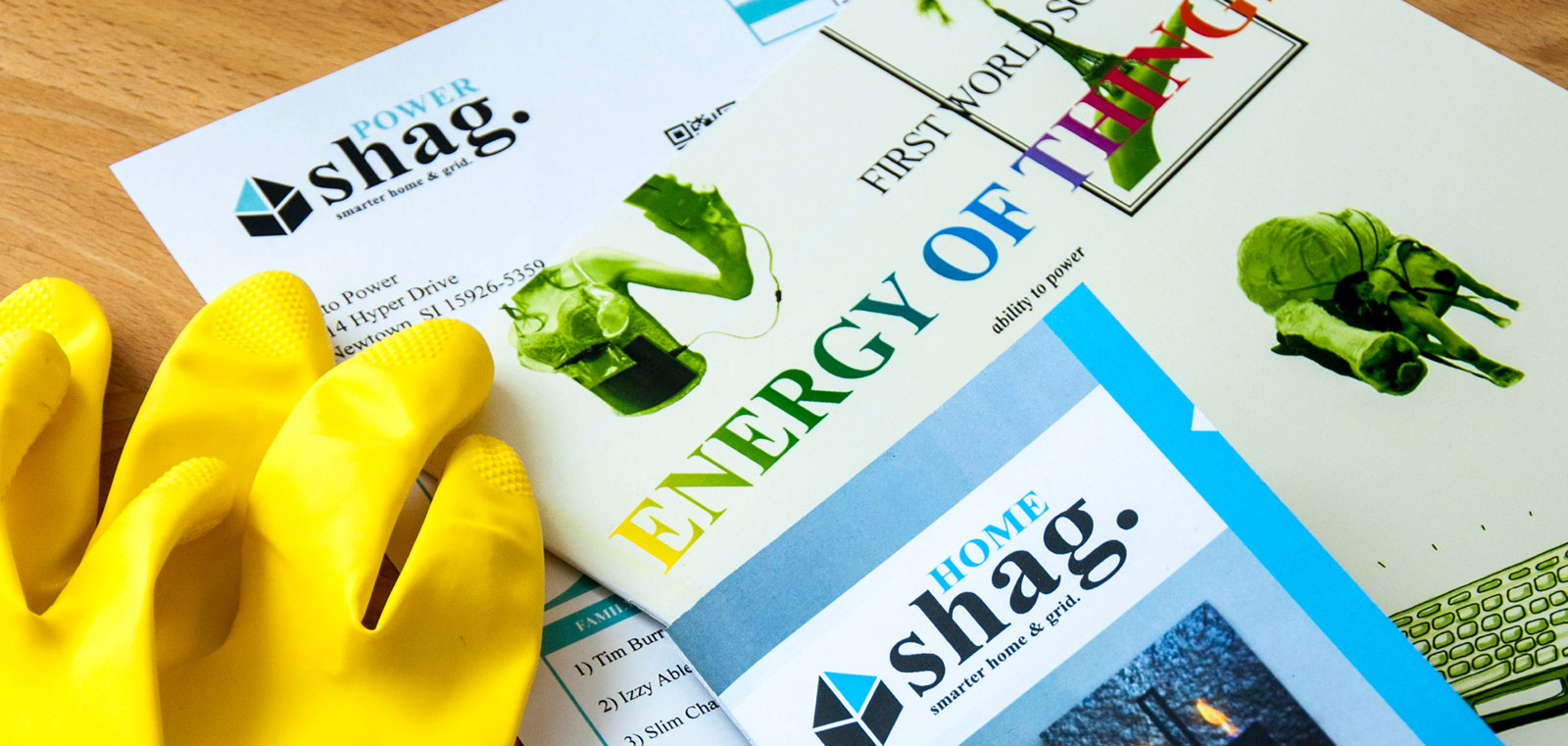
Humor in Design Fiction to Suspend Disbelief and Belief
This paper investigates humor as a resource and strategy for design with discourse as an intended outcome. While humor can incite empathy and understanding, it can also lead to alienation and disengagement. Through the detailing of the pre-narrative and narrative processes of an exemplar design fiction we describe why and how elements of humor, in particular puns, parody, and pastiche, were employed. Following the presentation of the fiction and its use in the design of an exhibition and diegetic prototypes, the paper presents responses from participants and audience members to reflect upon how humor was received within the design fiction. Following these reflections, as the near-future scenario was written four years prior to this paper and is now situated within present-day, it then concludes with a post-mortem reflection on the floating nature of humor.
TEI 2018 – Studio Call for Participation
Sociomateriality: Infrastructuring and Appropriation of Artifacts
Novel materials and innovative applications can sometimes outweigh a reflective perspective on the roles that objects and materials can play in social life. In this Studio, we want to bring together researchers and practitioners who are interested in exploring design outcomes from a sociomaterial perspective. By having prototypes at the center of the Studio activities, we intend to create prompted speculative fictions that link the material outcomes of design practice to social agency and cultural effects.
This studio will offer an opportunity to examine how objects might participate in social spheres as well as act as material bridges to their design process. We will do this through both hands-on examination of design objects, and inquiry into the infrastructuring and appropriation of these artifacts. The themes that will be examined are agency, material participation, and cultural performance of things. We encourage participants to bring their own prototypes.
We invite scholars and design practitioners from a variety of fields to register on the TEI 2018 website. For any questions, email the workshop organizers at mailto:hello@sociomaterial-things.com.
For any questions, email the workshop organizers at:
mailto:hello@sociomaterial-things.com.
More information you can find at the Studio webpage:
http://sociomaterial-things.com
Organizers
Tom Jenkins – Georgia Institute of Technology
Vasiliki Tsaknaki – KTH Royal Institute of Technology
Karey Helms – KTH Royal Institute of Technology
Ludvig Elblaus – KTH Royal Institute of Technology
Nicolai Brodersen Hansen – TU Eindhoven
DIS 2017 – Workshop Reflections and Design Fiction
As previously mentioned, I attended, and thoroughly enjoyed, the workshop at DIS17 on People, Personal Data and the Built Environment. Not only was the topic relevant to my project, interests, and background, but I also found the strict structure (and quick introductions) very effective and thus resulting in meaningful discussions at the end of the day.
The below image is a fraction of a future IoT system followed by a corresponding fictional narrative created with Albrecht Kurze.

Unfinished Business
2022 – five years after 2017 – a public space odyssey
It is the year 2022, five years after the government started to implement the dynamic waiting management system in public buildings. To simultaneously reduce waiting times while keeping visitors preoccupied, the system routes visitors on an adaptive, and often the least efficient, way through the building. As this has unsurprisingly resulted in many lost visitors, a place-based location-aware voice-controlled guiding and help-and-get-helped system was introduced, in which visitors can leave voice messages to aid other lost visitors.
Dave was born in 1950 and retired in 2017, the same year his wife died. Every time he enters public buildings, he is asked to confirm the usage and data processing terms of the building, as smart building are being classified as interactive data processing units by the 2019 extended GDPR. These temporary consents are based on minimum viable data and are thus only valid for a single visit as all data collected is automatically deleted or anonymized upon leaving.
Dave pretends to apply for a hunting license but actually just wants to hear his wife’s voice in a message she left in the help-and-get-helped system after the system’s implementation. As the system is gender intelligent, he needs a female to find his wife’s message. Furthermore, the message is not locationally linked nor directly addressable because of dynamic shuffling and the anonymization policy.
Claire was born in 2001 and has been applying for a family planning permit for the past five days. As the system is implicitly regulating family planning, prioritizing lonely widows and widowers for which Claire is not, it sends her on an impossible route. As she is not successful in her quest for a permit by the end of each day, the temporary data consent causes her to restart the whole process the following day, resulting in a never ending journey.
But this one special day Dave and Claire met, two lost visitors, trapped some way in and by the system. They decided to help each other and resolve their unfinished business.
DIS 2017 – Workshop on People, Personal Data and the Built Environment
Yesterday I attended the workshop Workshop on People, Personal Data and the Built Environment at DIS 2017. Was incredibly inspiring and perhaps the best workshop format I’ve experienced as of yet! Below is my position paper.
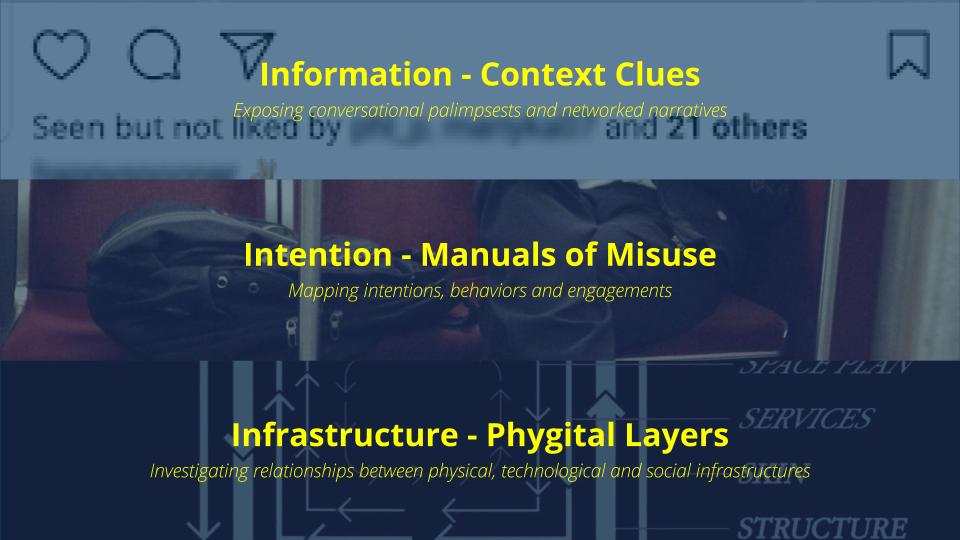
Implicit Interaction: Information, Intention and Infrastructure (position paper PDF)
In this position paper I present three in-progress design projects that are initial explorations into Smart Implicit Interaction, which is investigating data as a design material and a new paradigm of interaction for the Internet of Things. The first project, Context Clues, critically examines our existing interactions and exchange of implicit information across digital mediums. The second project, Manuals of Misuse, is an Internet of Things design brief in which students are exploring the peripheral intentions embedded within everyday objects to design novel connections while exposing hidden patterns of behavior and engagement. The third project, Phygital Layers, is an architectural study seeking to understand the implicit relationships between physical, technological and social infrastructures within domestic environments. While all three projects differ across scale and medium, they offer potential avenues of investigation into designing for people, data and the built environment.
Workshop – The Cultures of Machine Participation
Earlier this week I attended a workshop held by the research group for the design of information systems (DESIGN) at the University of Oslo (UiO) on The Cultures of Machine Participation.
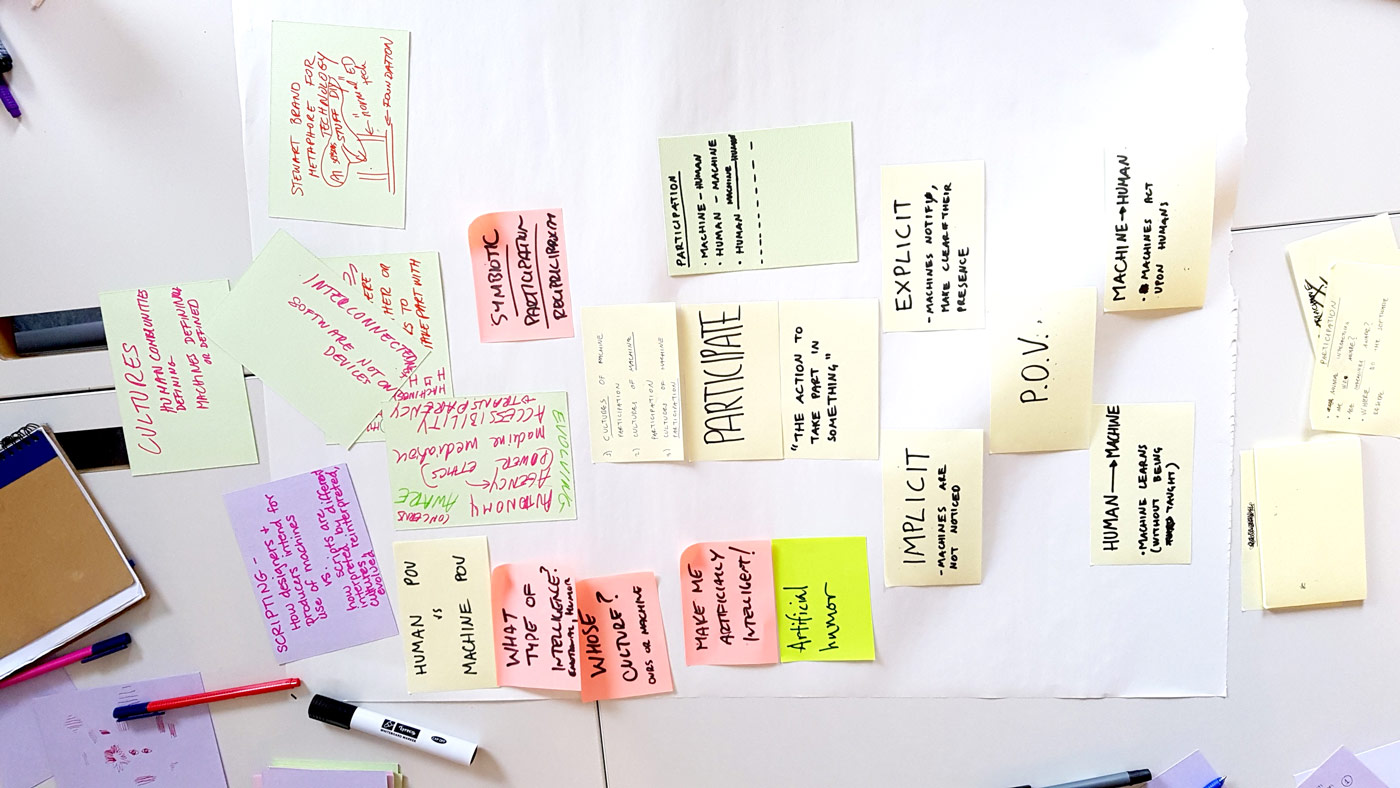
Registration Summer School
Last week I participated in the Registration Summer School, a three day workshop and lecture series held in Deptford, south-east London at the Old Tidemill School. Other than their kick-ass website, and despite a vague amount of information on the program of the three days, I was enticed to apply based on the simple objective – approaching problems in experimental ways – and the provocative theme – fear. And it was free, thus encompassing all my desired ingredients for an opportunity to meet and mingle with other London designers.

Photograph from Billy and Joe
As the theme of the week was fear, within our applications we were asked to submit our greatest fear, mine being doppelgängers. While in recent pop culture a doppelgänger typically refers to your celebrity look-alike, their cultural and literary history is much more intricate and ominous, often alluding to impending death or the prevailing subconscious. Even within its simplest abstraction, a doppelgänger can imply an unknown commonality of yourself, the end of individuality.
We were also asked to write a threatening letter to ourselves. I used this quote from Edgar Allan Poe’s William Wilson:
“You have conquered, and I yield. Yet, henceforward art thou also dead – dead to the World, to Heaven and to Hope! In me didst thou exist – and, in my death, see by this image, which is thine own, how utterly thou hast murdered thyself.”
Creepy stuff, complimented by the chosen location – Old Tidemill School in Deptford. The former primary school is currently inhabited by London property guardians, a couple of whom ran the summer school and hence used the location as a dual reason to establish purpose to the old building and hopefully delay demolition. After getting used to the child-sized bathrooms and an odd collection of scattered relics referencing the previous use, it was quite a fabulous space, inside and out.
MFA Thesis – UID Exhibition at Semcon
I was selected to exhibited and present my Interaction Design thesis project, The Family Circuit: A New Narrative of American Domesticity, with a group of other UID graduates for three days at Semcon in Göteborg, Sweden.

MFA Thesis – The Family Circuit report
First draft of my MFA thesis report has been ordered from blurb. PDF version available to download here.
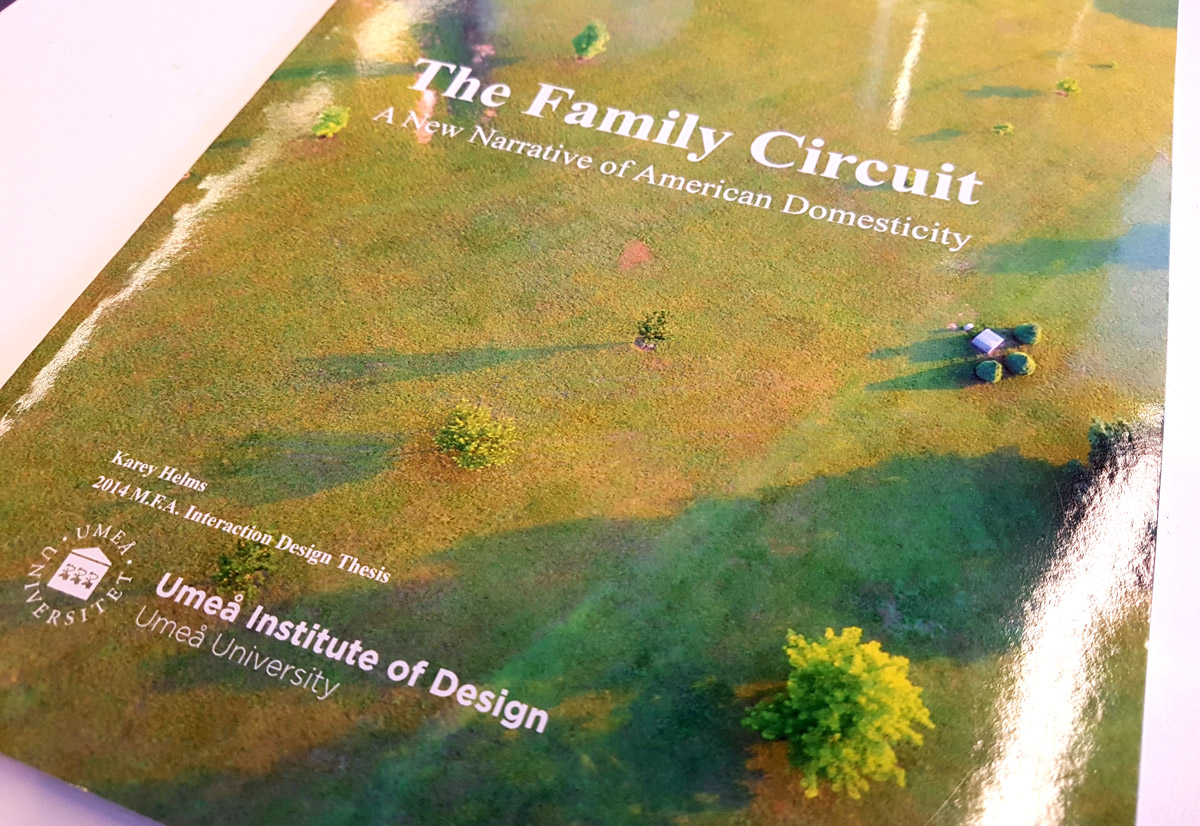
Thesis Narrative: Final Plot & Radio Show Script

Plot
Lotta Power wants her home to be ranked highly on the energy produciton list in the weekly shag. Home brochure. When she doesn’t see the Power family listed as a top net energy producer in Newtown, she becomes irritated. The brochure highlights the energy harvesting potential of the piezoelectric shag Carpet Footprint already installed in the Power family’s central home energy system. In order to stimulate more energy production while also inhibiting consumption, she hides Max’s headphones so he cannot work on his ambient DJ album. Frustrated, as she anticipated, Max begins searching frantically, running around the house and thus generating electricity as his feet rub and pounded on the shag carpet. Though, in his fervent searching, he causes a ruckus and wakes sleeping Minnie frightfully from her nap. As Minnie begins to cry profusely, she no longer sucks on the energy harvesting Pacify Her that Robin personally uses to charge her smartphone. Right as Minnie drops the Pacify Her, Robin receives a text notification about a new submission to Suburban Dictionary, the website she founded and manages, but doesn’t have time to read it before her phone dies. As Minnie is still crying and refuses the Pacify Her, Robin begins to suck on it herself. Otto wishes to watch the morning news before heading to work, but sees the television is low on power and Lotta has disconnected it from the central home energy system. As he observes Robin awkwardly with the Pacify Her, he luckily has just enough power in his phone to seize the opportunity to take a photo and post it to Instagram. Just as Robin’s phone turns back on, charged by the pacifier, she sees the image Instagram and becomes furious. Since she doesn’t want to loose power in her phone and thus continues sucking on the pacifier and expresses her anger through violent gestures. Luckily, she is wearing the Temper Trap purchased by Otto, which harvests energy from vigorous movement and skaking. As she intensely expresses her emotions over the photo, Otto is able to wirelessly charge the TV with energy harvested from the Temper Trap. Overheated from emotion, Robin turns on the air conditioning, which is part of the central home energy production system, draining the house of all recently produced energy. The Power family is no powerless.
Thesis Gateway Presentation Feedback
Following my gateway presentation last Friday, I received a lot of helpful feedback regarding my next steps and exhibition priorities and setup. During my presentation I skipped all previous background and process material and essentially launched into a narrative of the fictional world and characters I’ve created – you can read the first draft iteration of The Family Circuit: A New Narrative in American Domesticity.
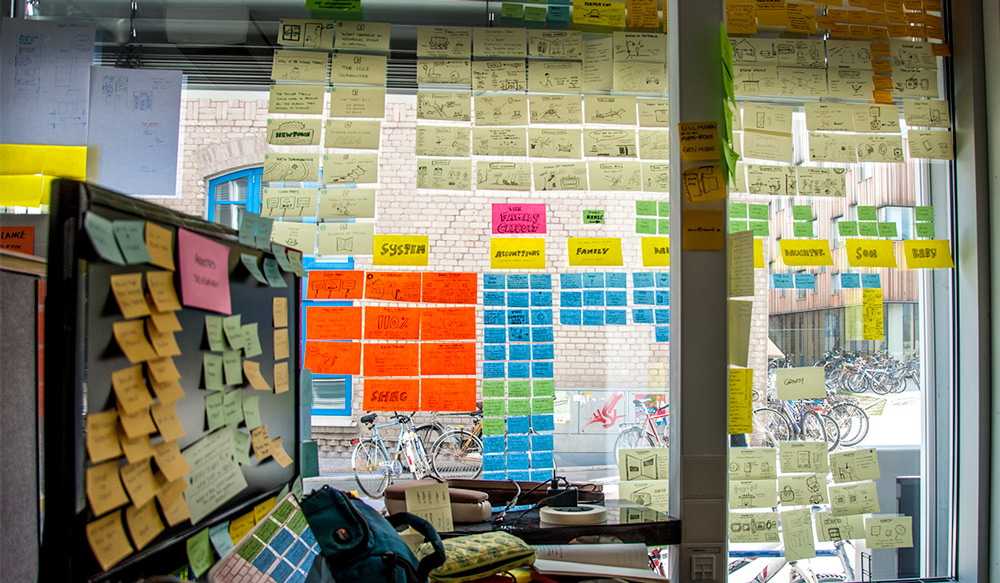
Feedback from reviewers included:
- Finding a balance between conveying main message quickly vs requiring in depth analysis. Is the goal to get the message quickly? Essentially, my exhibition needs to be able to cater to those with a short attention span, while also allowing the various layers of the project and story to reveal over more time and with additional material. I personally am more inclined to cater to the latter, as I feel making the message overly explicit will sacrifice the experience of peeling back the layers.
- Emphasis on storytelling: be sure to connect and relate the characteristics of the characters into and through the cycles of daily events (something I have but need to work on making more explicit and central).
- 5 minute presentation at design talks could be a a narrative describing the world and omitting the why/how I got here. Of course, followed by an ‘if you want to see more, check out my exhibition…’
- Make the exhibition minimal, highlighting the artifacts. Hint at other aspects of family life, but don’t overload with unnecessary details.
- START STAGING NOW. Make a mini mockup of the exhibition plan, which could also inform if I want to make it full scale (most likely) or something along the lines of a cornell box.
- Various supplementary ideas: Pulp fiction book, digital photo frame, Whole Earth Catalog (love love!), mockumentary (Modern Family & The Office – REALLY which I had time for this, but unsure)
- Make my infomercial idea a higher priority
- Make objects in photos/GIFs/video pop in relation to Energy of Things catalog
- Match the exhibition setting to the scenes used in supplementary material
- Don’t forget to relate and check back to my original intention: energy consumption awareness
My own thoughts & reflections:
- Lots to do!
- Keep having fun!
The Family Circuit: A New Narrative of American Domesticity
Last Friday was IxD thesis gateway presentations – more so a private discussion with tutors and reviewers to assess our thesis progress, plans, and priorities for the upcoming five weeks. As my thesis is taking a strong design fiction direction, I did not give a presentation, yet read my draft narrative. To be completed this week, but please enjoy the preview below… it’s proudly quite ‘punny’ (wink wink).

The Family Circuit: A New Narrative of American Domesticity
It was a cloudy morning in early May, as were most days in Newtown. Otto Power approached the front door to check the weather, only to encounter resistance. Annoyed at the door’s conduct (tivity), he countered the friction with force, and it hesitantly opened – subtly challenging his potential motive while also directly insinuating the impending consequence. Going outside before breakfast was a break in Otto’s usual morning routine, especially for a weekday, and the mental energy used by the intelligent door to evaluate the uncommon situation would cost him the required electricity for a warm cup of coffee. Otto already speculated as much, for it was rare to have a morning electrical surplus. But he had woken with a vague yet irrepressible weight growing in his body, for Otto Power was tired. And so the forthcoming electricity sacrifice failed to impede the growing hope of a different day, and as he stepped outside he thoughtfully wondered aloud, “Will it be windy today?”
